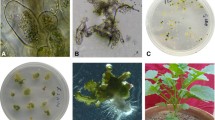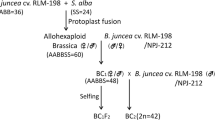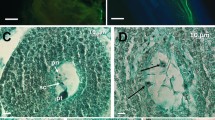Abstract
Somatic hybrids were produced by PEG-induced symmetric and asymmetric protoplast fusions in order to transfer resistance to Alternaria brassicicola, A. brassicae, Phoma lingam, Plasmodiophora brassicae and Turnip mosaic virus (TuMV) into Brassica oleracea var. capitata (cv. ‘Toskama’) and botrytis (cv. ‘Korso’). As resistance donors, ten species belonging to several genera of the family Brassicaceae including wild relatives were used. Of 2,189 plants (somatic hybrids, partially in vitro cloned) tested, 1,616 (73.8%) were resistant against at least one of the pathogens, indicating that, mostly, a successful resistance transfer has taken place. Five hundred and twenty-two hybrids showed multiple resistances to two, three and, in a single case, to four pathogens. Irrespective of the donor parents used in the fusion, a broad variability in symptom manifestation ranging from 0 (without symptoms) to 9 (highly susceptible) could be observed. With regard to the Alternaria pathogens, Sinapis alba, B. nigra and B. juncea were the most effective resistance donors, whereas fusions with Raphanus sativus resulted in the most hybrids with resistance to clubroot and TuMV. As could be shown especially in asymmetric fusions with S. alba, Barbarea vulgaris and Hesperis matronalis, transferred resistance to a pathogen may not correspond with resistance exhibited by the donor parent. Some combinations in which both parents were highly susceptible, e.g. R. sativus (+) B. oleracea var. capitata, yielded hybrids that exhibited strong resistance, e.g. to A. brassicicola, revealing that a new type of resistance might be occurring. With regard to the Alternaria pathogens, resistance expression was very unstable. Many hybrids into which (also variable) resistance of some donors, such as B. vulgaris, S. alba and B. carinata, was transferred became as highly susceptible as those of which the fusion parents did not show any resistance reaction (e.g. R. sativus). For reliable characterization of the resistance response, hybrids should be subjected to several resistance tests during growth period of the host, at least until flowering.



Similar content being viewed by others
References
Anonym (UK, CAB International) (2005) Leptoshaeria maculans (distribution map). Distribution maps of plant diseases. CAB International, Wallingford, Oxfordshire, UK, Edition 6: Map 73
Bauer R (1990) Protoplast manipulation in the genus Brassica. II, fusion of leaf and callus protoplasts and the selection of heterokaryons. Biol Zentr Bl 109:63–69
Brown J, Brown AP, Davis JB, Erickson D (1997) Intergeneric hybridization between Sinapis alba and Brassica napus. Euphytica 93:163–168
Buczacki ST, Toxopeus H, Mattusch P, Johnston TD, Dixon GR, Hobolth LA (1975) Study of physiologic specialization in Plasmodiophora brassicae: proposals for attempted rationalization through an international approach. Trans Brit Mycol Soc 65:295–303
Chèvre AM, Eber F, Brun H, Plessis J, Primard F, Renard M (1991) Cytogenetic studies of Brassica napus-Sinapis alba hybrids from ovary culture and protoplast fusion: attempts to induce Alternaria resistance into rapeseed. GCIRC 8th Intern Rapeseed Congr, Saskatoon, pp 346–351
Chèvre AM, Brun H, Eber F, Letanneur JC, Vallee P, Ermel M, Glais I, Li H, Sivasithamparam K, Barbetti MJ (2008) Stabilization of resistance to Leptosphaeria maculans in Brassica napus–B. juncea recombinant lines and its introgression into spring-type Brassica napus. Plant Dis 92:1208–1214
Christey MC (2004) Brassica protoplast culture and somatic hybridization. In: Pua EC, Douglas CJ (eds) Biotechnology in agriculture and forestry, Brassica. 54. Springer, Heidelberg, pp 119–148
Clark MF, Adams AN (1977) Characteristics of the microplate method of enzyme-linked immunosorbent assay for the detection of plant viruses. J Gen Virol 34:475–483
Diederichsen E (1992) Kombination verschiedener Resistenzen gegenüber Plasmodiophora brassicae Wor. in synthetisierten Formen von amphidiploiden Brassica-Arten. Diss Fachber Biologie Freie Univ, Berlin, p 172
Domsch KH (1957) Die Raps- und Kohlschotenschwärze. Z Pflanzenk Pflanzen 64:65–79
Dorokhov BD, Klocke E (1997) A rapid and economic technique for RAPD analysis of plant genomes. Russ J Genet 33:358–365
Ferreira ME, Dias JS, Mengistu A, Williams PH (1993) Screening of Portuguese cole landraces (Brassica oleracea L.) with Leptosphaeria maculans and Xanthomonas campestris pv. campestris. Euphytica 65:219–227
Girish G, Saifulla M, Gowda MB, Mahesh M, Satheesh N (2007) Screening of Indian mustard genotypes and advanced materials for white rust and Alternaria leaf blight diseases. Environ Ecol 25S(special 3A):838–841
Hagimori M, Nagaoka M, Kato M, Yoshikawa H (1992) Production and characterization of somatic hybrids between Japanese radish and cauliflower. Theor Appl Genet 84:819–824
Hammer K (1993) The 50th anniversary of the Gatersleben gene bank. FAO/IBPGR Plant Genet Res Newsl 91:1–8
Hansen LN (1998) Intertribal somatic hybridization between rapid cycling Brassica oleracea L. and Camelina sativa (L.) Crantz. Euphytica 104:173–179
Hansen LN, Earle ED (1997) Somatic hybrids between Brassica oleracea L. and Sinapis alba L. with resistance to Alternaria brassicae (Berk.) Sacc. Theor Appl Genet 94:1078–1085
Humpherson-Jones FM (1992) Epidemiology and control of dark leaf spot of brassicas. In: Chełkowski J, Visconti A (eds) Alternaria: biology, plant diseases and metabolites. Elsevier, London, pp 267–288
Husain A, Thakur RN (1963) Some sources of resistance to Alternaria blight of rapeseed and mustard. Indian Oilseeds J 7:259–261
Jenner CE, Walsh JA (1996) Pathotypic variation in turnip mosaic virus with special reference to European isolates. Plant Pathol 45:848–856
Krämer R, Marthe F, Klocke E, Ryschka U, Schumann G, Clauss E (1998) Radish (Raphanus sativus L.) as a resistance resource to turnip mosaic virus. 9th Conf of ISHS Vegetable Virus Working Group, Turino, Italy, 43–46
Krämer R, Marthe F, Klocke E, Ryschka U, Clauss E, Schumann G (2002) Resistenz gegen das Kohlschwarzringflecken-Virus (Turnip mosaic virus) in Brassica oleracea-Primitivformen. Pflanzenschutzberichte 60:45–53
Krämer R, Scholze P, Marthe F, Ryschka U, Klocke E, Schumann G (2003a) Verbesserung der Krankheitsresistenz von Kohlgemüse: 1. Turnip mosaic virus (TuMV). Gesunde Pflanz 55:193–198
Krämer R, Schubert J, Ehrig F (2003b) Comparison of Turnip mosaic virus isolates from Brassicaceae by biological, molecular and cytological methods. J Plant Dis Protect 110:92–93
Marthe F, Krämer R, Schubert J, Ryschka U (2004) Nutzung von Resistenz gegen das Turnip mosaic virus (TuMV) in der Gattung Brassica. Vortr Pflanzenzüchtg 63:193–198
Murashige T, Skoog F (1962) A revised medium for rapid growth and bioassays with tobacco tissue cultures. Physiol Plant 15:473–497
Pace MA, Campbell R (1974) The effect of saprophytes on infection of leaves of Brassica spp. by Alternaria brassicicola. Trans Br Mycol Soc 63:193–196
Pink DAC, Walkey DGA (1990) Resistance to turnip mosaic virus in white cabbage. Euphytica 51:101–107
Plümper B (1995) Somatische und sexuelle Hybridisierung für den Transfer von Krankheitsresistenzen auf Brassica napus L. Diss Fachber Biologie Freie Univ, Berlin
Primard C, Vedel F, Mathieu C, Pelletier G, Chèvre AM (1988) Interspecific somatic hybridization between Brassica napus and Brassica hirta (Sinapis alba L.). Theor Appl Genet 75:546–552
Ren JP, Dickson MH, Earle ED (2000) Improved resistance to bacterial soft rot by protoplast fusion between Brassica rapa and B. oleracea. Theor Appl Genet 100:810–819
Rimmer SR, Scarth R, McVetty PBE, Woods D, Gugel R, Séguin-Swartz G (1995) Breeding for resistance to blackleg (stem canker) in Western Canada. Blackleg News 95:11–15
Rotem J (1994) The genus Alternaria: biology, epidemiology and pathogenicity. APS Press, St Paul
Rowe RC (1980) Evaluation of radish cultivars for resistance to clubroot (Plasmodiophora brassicae) race 6 in Midwestern United States. Plant Dis 64:462–464
Ryschka U, Schumann G, Klocke E, Scholze P, Neumann M (1996) Somatic hybridization in Brassicaceae. Acta Hort 407:201–204
Ryschka U, Schumann G, Klocke E, Scholze P, Krämer R (1999) Somatic cell hybridization for transfer of disease resistance in Brassica. In: Altmann A, Ziv M, Izhar S (eds) Plant biotechnology and in vitro biology in the 21st century. Kluwer, Dordrecht, pp 205–208
Ryschka U, Klocke E, Schumann G, Warwick S (2003) High frequency recovery of intergeneric fusion products of Brassica oleracea (+) Lepidium meyenii and their molecular characterization by RAPD and AFLP. Acta Hort 625:145–151
Sarla N, Raut RN (1988) Synthesis of Brassica carinata from Brassica nigra x Brassica oleracea hybrids obtained by ovary culture. Theor Appl Genet 76:846–849
Scholze P (1995) Einführung eines Prüfverfahrens zur Recherche nach Resistenz gegen Alternaria und Phoma in progenerativen Stadien von Brassicaceen. Ann Report Fed Centre Breed Res Quedlinburg 1994, p 106
Scholze P, Hammer K (1998) Evaluation of resistance to Plasmodiophora brassicae, Alternaria and Phoma in Brassicaceae. Acta Hort 459:363–369
Scholze P, Hammer K (1999) Results of resistance evaluations in Brassicaceae with Plasmodiophora brassicae, Alternaria and Phoma lingam. In: Mugnozza GTS, Porceddu E, Pagnotta MA (eds) Genetics and breeding for crop quality and resistance. Kluwer, Dordrecht, pp 43–50
Scholze P, Willner E (1997) Wildformen von Brassicaceen: potentielles Reservoir für Resistenzdonoren. Angewandte Wissenschaft 465:369–371
Scholze P, Malorny M, Dippe R (2002) A comparative study of reaction to clubroot (Plasmodiophora brassicae Wor.) by inoculating plants with single races or a race mixture. J Plant Dis Protect 109:217–226
Scholze P, Krämer R, Marthe F, Ryschka U, Klocke E, Schumann G (2003) Verbesserung der Krankheitsresistenz von Kohlgemüse: 2. Kohlhernie, Alternaria- und Phoma-Blattfleckenkrankheit. Gesunde Pflanz 55:199–204
Sheng X, Liu F, Zhu Y, Zhao H, Zhang L, Chen B (2008) Production and analysis of intergeneric somatic hybrids between Brassica oleracea and Matthiola incana. Plant Cell Tiss Organ Cult 92:55–62
Shivanna KR, Sawhney VK (1993) Pollen selection for Alternaria resistance in oilseed brassicas: responses of pollen grains and leaves to a toxin of A. brassicae. Theor Appl Genet 86:339–344
Sigareva M, Ren JP, Earle ED (1999) Introgression of resistance to Alternaria brassicicola from Sinapis alba to Brassica oleracea via somatic hybridization and backcrosses. Cruciferae Newsl 21:135–136
Sjödin C, Glimelius K (1989) Transfer of resistance against Phoma lingam to Brassica napus by asymmetric somatic hybridization combined with toxin selection. Theor Appl Genet 78:513–520
Sundberg E, Glimelius K (1986) A method for production of interspecific hybrids within Brassicaceae via somatic hybridization, using resynthesis of Brassica napus as a model. Plant Sci 43:155–162
Walsh JA, Jenner CE (2002) Turnip mosaic virus and the quest for durable resistance. Mol Plant Pathol 3:289–300
Walsh JA, Rusholme RL, Hughes SL, Jenner CE, Bambridge JM, Lydiate DJ, Green SK (2002) Different classes of resistance to turnip mosaic virus in Brassica rapa. Eur J Plant Pathol 108:15–20
Williams PH, Delwiche PA (1979) Screening for resistance to blackleg of crucifers in the seedling stage. Proc Eucarpia conf breed crucif crops, pp 164–170
Zhu JS (1991) Selektion auf Phoma lingam- und Alternaria brassicae-Resistenz in den Gattungen Brassica und Sinapis. Diss Fachber Agrarwiss Univ Göttingen
Acknowledgments
We would like to thank Mrs. E. Zjaba, A. Krüger, M. Malorny, and R. Dippe for excellent technical assistance.
Author information
Authors and Affiliations
Corresponding author
Rights and permissions
About this article
Cite this article
Scholze, P., Krämer, R., Ryschka, U. et al. Somatic hybrids of vegetable brassicas as source for new resistances to fungal and virus diseases. Euphytica 176, 1–14 (2010). https://doi.org/10.1007/s10681-010-0205-0
Received:
Accepted:
Published:
Issue Date:
DOI: https://doi.org/10.1007/s10681-010-0205-0




